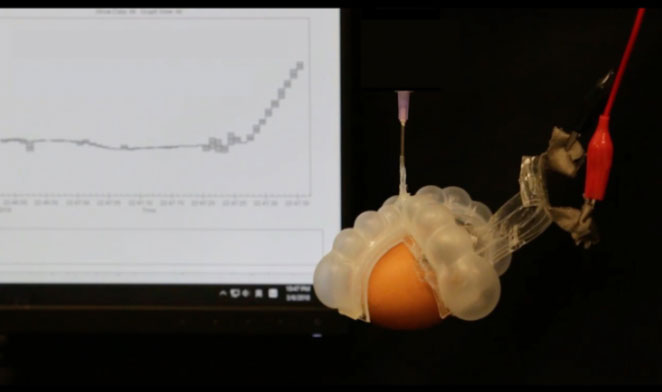Successfully developed a 10 millisecond response stretch thermometer
Scientists have developed a flexible, stretchy thermal sensor that is simple in construction and responds very quickly to temperature changes.
In the future, soft robots, smart clothing, and biocompatible medical devices will need to integrate soft sensors that can stretch and twist according to the device or wearer. The challenge here is that most of the components used in traditional sensors are stiff.

Test using soft tongs with built-in thermometer to measure the temperature of hot boiled eggs.
However, a team at Harvard University's John A. Paulson School of Engineering and Applied Science (SEAS) has developed a soft, stretchy, self-powered thermometer that can be integrated into electronics and soft robots, Phys reported on January 24. The new study was published in the journal Proceedings of the National Academy of Sciences.
"We develop soft temperature sensors with high sensitivity and fast response times, opening up new possibilities for creating human-machine interfaces and soft robotics in the fields of medical, engineering and entertainment," said Zhigang Suo, a professor of mechanical engineering and materials at SEAS and a member of the research team.
The thermometer consists of three simple components: an electrolyte, an electrode, and a dielectric material for separation. The electrolytic/dielectric interface accumulates ions while the dielectric/electrode interface accumulates electrons. The charge imbalance between them creates an ion cloud in the electrolyte. As the temperature changes, the ion cloud changes in thickness and a voltage is generated. Voltage is sensitive to temperature but not to expansion.
"The design is so simple that there are many ways to adjust the sensor, depending on what you're using it for. You can choose different materials, arrange in different ways, and optimize for each task." , Yecheng Wang, postdoctoral fellow at SEAS, research team member, explains.
By arranging the electrolyte, dielectric and electrode in different structures, the team developed four designs for the temperature sensor. In one test, they integrated the sensor into a soft tong and measured the temperature of a hot hard-boiled egg. The sensors are more sensitive than traditional thermoelectric thermometers, which can respond to temperature changes in as little as 10 milliseconds.
"We've demonstrated that these sensors can be made compact, stable, even transparent. Depending on the material used, the thermometer can measure temperatures as high as 200 degrees Celsius or as low as lows. to -100 degrees Celsius," Wang said.
- Newly developed thermometers do not need to be clipped to the armpit or placed under the tongue
- The most accurate thermometer in the world
- Largest thermometer tree in China
- Japan develops ultra-thin thermometers with only 1/4 of the hair
- Handle when the thermometer breaks to avoid mercury poisoning
- Fever Smart - Smart thermometer
- The world's largest thermometer
- Vietnam established 4 quick response teams for Ebola response
- Rubber wires can stretch up to 8 times
- Clock predicts danger imminent
- Ultra-accurate thermometer
- Iran successfully developed the bomb
 The US company is about to build a supersonic passenger plane of 6,000km / h
The US company is about to build a supersonic passenger plane of 6,000km / h Japan develops avatar robot as in fiction film
Japan develops avatar robot as in fiction film Australia tested the world's first mango picking robot
Australia tested the world's first mango picking robot America develops technology to separate water from animal waste
America develops technology to separate water from animal waste